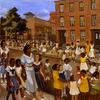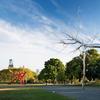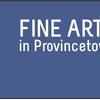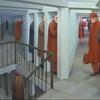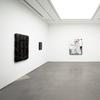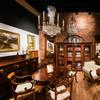Five Decades of Helen Frankenthaler's Innovation in Printmaking On View at Princeton
- PRINCETON, New Jersey
- /
- June 25, 2019
Helen Frankenthaler Prints: Seven Types of Ambiguity, on view this summer at the Princeton University Art Museum, explores abstraction in postwar American art
One of the most influential artists to emerge from the mid-20th century, Helen Frankenthaler (1928-2011) may be best known for her innovative abstract paintings in which she poured washes of color over great expanses of raw canvas. She was also the most prolific printmaker of her generation. Frankenthaler’s print works are remarkable for the diversity of techniques she employed, the number of studios with which she collaborated and the ways in which her engagement with printmaking could parallel – simultaneously independent and in sync with – her practice as a painter. More than 50 prints by the artist, spanning five decades and more than a dozen printmaking processes, including lithography, woodcut, etching and engraving, will be on view at the Princeton University Art Museum from June 29 through Oct. 20, 2019. Helen Frankenthaler Prints: Seven Types of Ambiguity examines the continuous and generative role of printmaking throughout Frankenthaler’s career, while also tracing the ascendance of American printmaking in the latter half of the 20th century.
The exhibition will highlight a selection of outstanding prints, in a variety of media, which were donated to the Princeton University Art Museum by the Helen Frankenthaler Foundation last year as part of the Frankenthaler Prints Initiative for university-affiliated museums. The gift’s 10 prints and five working proofs are joined by important loans of additional prints from the Frankenthaler Foundation, from public and private collections and selections from the Museum’s rich holdings in prints. The exhibition will also feature historical works by an array of artists whose printmaking inspired Frankenthaler’s creative choices, including Edgar Degas (French, 1834-1917), Utagawa Hiroshige I (Japanese, 1797-1858) and Rufino Tamayo (Mexican, 1899-1991).
Helen Frankenthaler Prints: Seven Types of Ambiguity is curated by Mitra Abbaspour, Haskell Curator of Modern and Contemporary Art, and Calvin Brown, associate curator of prints and drawings, at the Princeton University Art Museum. John Elderfield, the Museum’s outgoing Allen R. Adler, Class of 1967, Distinguished Curator and Lecturer, has acted as project consultant.
“Helen Frankenthaler’s achievement and legacy as a visionary practitioner and a legendary mentor for so many cannot be overstated,” said James Steward, Nancy A. Nasher–David J. Haemisegger, Class of 1976, director. “The generosity of the Frankenthaler Foundation is acting as a catalyst for us to consider more fully the artist’s achievements in print, a medium uniquely suited to her vision.”
Helen Frankenthaler Prints: Seven Types of Ambiguity is organized in seven loosely chronological sections that each profiles a distinct approach to her work in printmaking. The subtitle of the exhibition is taken from literary critic William Empson’s 1930 iconic essay Seven Types of Ambiguity, which articulated ways in which the formal structures of language could convey a multiplicity of meanings in poetry. For the postwar generation of American artists, writers and critics, Empson’s essay was not only the foundational work for the literary theory known as New Criticism, it also had a profound and lasting impact on abstract artists. In 1957 Frankenthaler borrowed the title of the essay for her large-scale stain-painting Seven Types of Ambiguity, which will open the exhibition, making clear her own affinity for Empson’s approach. Variously focusing on Frankenthaler’s compositional language, working process, historical referents and collaborations with particular printmaking studios, the exhibition embraces the central principle of Empson’s book: that close reading, like close looking, can yielddeep relationships with an abstract composition.
Frankenthaler’s innovative artistic career emerged with force in the 1950s, a period in which seeds were planted that would blossom into a printmaking renaissance in a handful of key American workshops by the end of the decade. The leading print studios, Universal Limited Art Editions (ULAE) in New York, Tyler Graphics in Bedford Village, New York (and later Mount Kisco, New York), and Crown Point Press in San Francisco, were known for pairing skilled master printers with prominent artists in collaborative creative partnerships, such as the relationship Frankenthaler began in earnest with ULAE in 1960.
The exhibition begins with Frankenthaler’s first color lithograph, printed in 1961, followed by a series of works in a variety of techniques that include screenprint, etching, aquatint and lithography that balance layers of linear gestures with fields of color. Subsequent sections explore the artist’s creative process, her expressive use of black ink, one-of-a-kind monotypes created in San Francisco and New York and Mixografia relief prints. The exhibition culminates with sumptuous examples of her distinctive color woodcuts, printed in water-soluble inks by the master craftsman Yasuyuki Shibata in traditional Japanese ukiyo-e manner and created in partnership with Ken Tyler at Tyler Graphics.
For more information: artmuseum.princeton.edu

